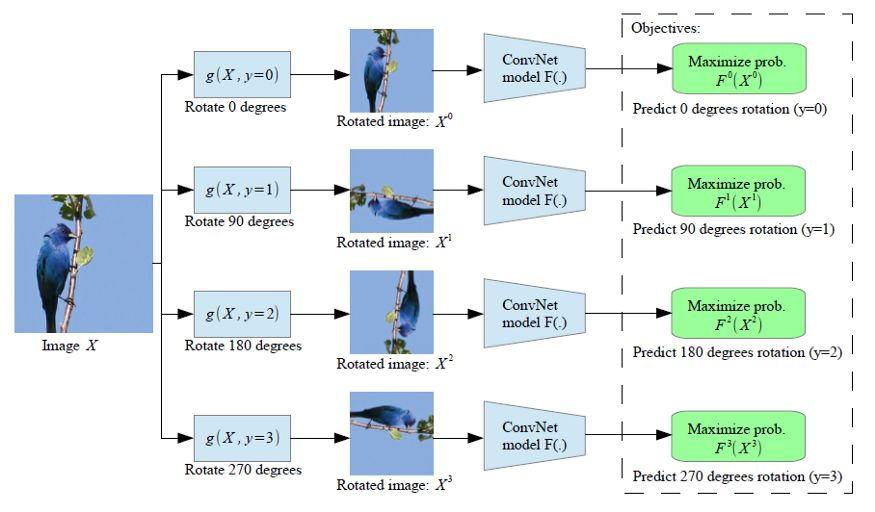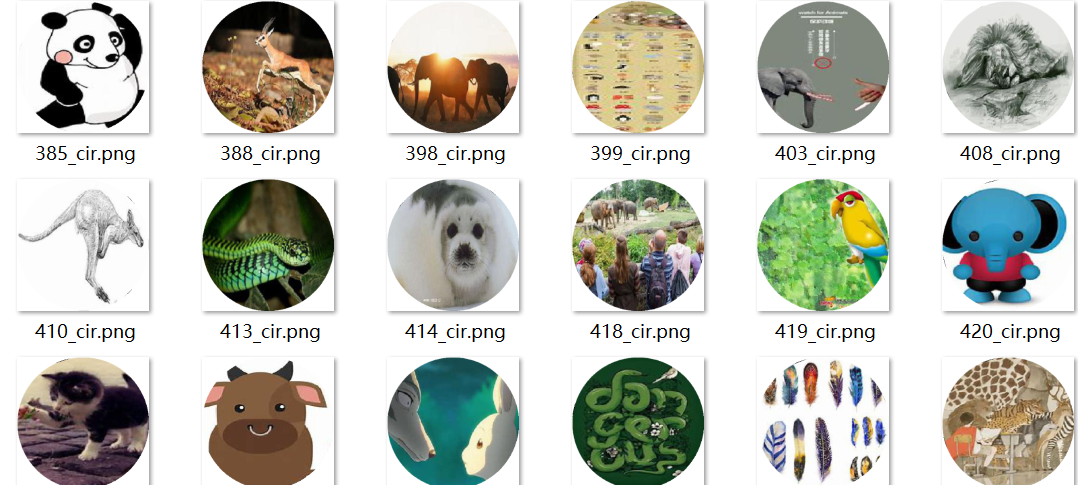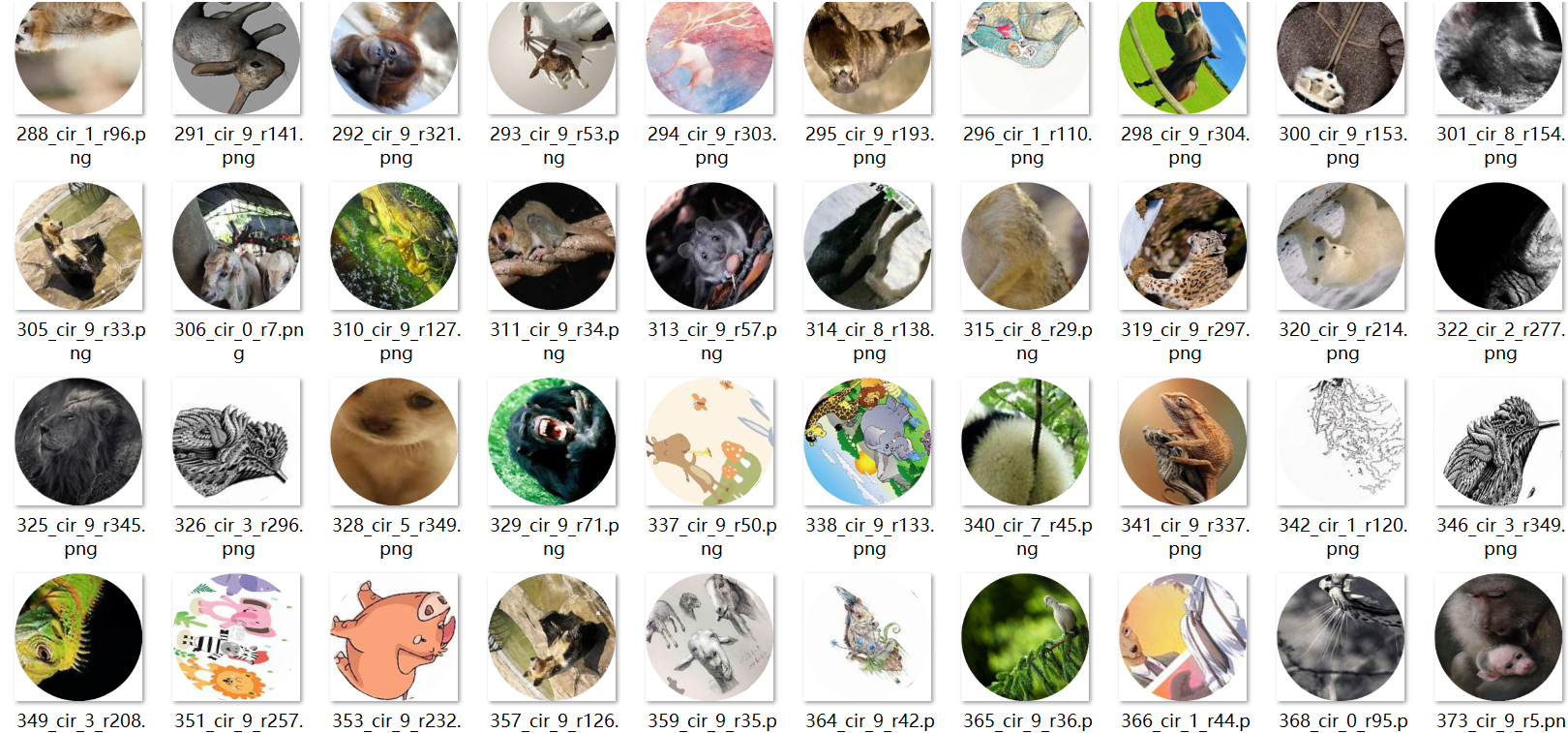Thesis Guide
RotNet performs self supervised learning by predicting image rotation
This is a paper published by ICLR in 2018, which has been cited more than 1100 times. The idea of this paper comes from: if someone does not understand the concept of the object depicted in the image, he cannot recognize the rotation applied to the image.
In this article, we review the unsupervised representation learning by predicting image rotation at the University Paris Est. Using RotNet, image features are learned by training ConvNets to recognize 2d rotation applied to the image as input. Through this method, the unsupervised pre training AlexNet model achieves 54.4% of the mAP, which is only 2.4 points lower than the supervised AlexNet.
Image rotation prediction framework

Given four possible geometric transformations, namely 0, 90, 180 and 270 degree rotations, the convolution network model F(:) is trained to identify which rotation is applied to the input image.
Fy(Xy) is the probability of rotation transformation y predicted by model F(:), its input is an image that has been rotated and transformed, and the rotation angle of the output image.
In order to successfully predict the rotation of the image, ConvNet model must learn to locate the significant targets in the image, identify their direction and object type, and then associate the object direction with the original image.

The attention map generated by the trained AlexNet model (a) identifies the object (supervised) and (b) identifies the image rotation (self supervised).
The above attention map is calculated according to the activation amplitude of each spatial unit of the convolution layer, which essentially reflects where the network focuses most of its attention to classify the input image.
On the way, it can be seen that both the supervised model and the self supervised model seem to focus on roughly the same image area.
Rotating and dragging verification code solution
Once upon a time, were you troubled by a rotary verification code? Yes, today's topic - Rotary verification code.

When simulating login, the picture verification code is a big difficulty.
But yes RotNet , this problem will be solved easily Rotating and dragging verification code solution.
Two ideas
Image rotation considers two ideas: regression and classification
- Regression: the predicted numerical results range from 0 to 360 °
- Classification: predict 360 categories. The model predicts which category has the greatest probability of output
The convolution neural network is defined to train the rotating picture set to predict the rotation angle of the picture.
Big data application competition
Big data application competition : computer vision is widely used in many AI, such as automatic driving, visual navigation, target detection, target recognition and so on. All of them are related to computer vision, and image technology can often help improve computer vision, such as random clipping, random rotation, image blur and so on. The importance of image technology to computer vision is self-evident, so the title of this big data application competition is image righting challenge.


Convolutional neural network
Classification code:
# number of convolutional filters to use nb_filters = 64 # size of pooling area for max pooling pool_size = (2, 2) # convolution kernel size kernel_size = (3, 3) # number of classes nb_classes = 360 # model definition input = Input(shape=(img_rows, img_cols, img_channels)) x = Conv2D(nb_filters, kernel_size, activation='relu')(input) x = Conv2D(nb_filters, kernel_size, activation='relu')(x) x = MaxPooling2D(pool_size=(2, 2))(x) x = Dropout(0.25)(x) x = Flatten()(x) x = Dense(128, activation='relu')(x) x = Dropout(0.25)(x) x = Dense(nb_classes, activation='softmax')(x) model = Model(inputs=input, outputs=x) model.summary()
Model compilation
# model compilation
model.compile(loss='categorical_crossentropy',
optimizer='adam',
metrics=[angle_error])
Training parameters
# training parameters batch_size = 128 nb_epoch = 50
Callback
# callbacks
checkpointer = ModelCheckpoint(
filepath=os.path.join(output_folder, model_name + '.hdf5'),
save_best_only=True
)
early_stopping = EarlyStopping(patience=2)
tensorboard = TensorBoard()
model training
# training loop
model.fit_generator(
RotNetDataGenerator(
X_train,
batch_size=batch_size,
preprocess_func=binarize_images,
shuffle=True
),
steps_per_epoch=nb_train_samples / batch_size,
epochs=nb_epoch,
validation_data=RotNetDataGenerator(
X_test,
batch_size=batch_size,
preprocess_func=binarize_images
),
validation_steps=nb_test_samples / batch_size,
verbose=1,
callbacks=[checkpointer, early_stopping, tensorboard]
)
Complete code
"""
@Author: ZS
@CSDN : https://zsyll.blog.csdn.net/
@Time : 2021/11/20 10:48
"""
from __future__ import print_function
import os
import sys
from keras.callbacks import ModelCheckpoint, EarlyStopping, TensorBoard, ReduceLROnPlateau
from keras.applications.resnet50 import ResNet50
from keras.applications.imagenet_utils import preprocess_input
from keras.models import Model
from keras.layers import Dense, Flatten
from keras.optimizers import SGD
sys.path.append(os.path.dirname(os.path.dirname(os.path.abspath(__file__))))
from utils import angle_error, RotNetDataGenerator
from getImagePath import getPath
data_path = r'./data/image/'
train_filenames, test_filenames = getPath(data_path)
print(len(train_filenames), 'train samples')
print(len(test_filenames), 'test samples')
model_name = 'rotnet_resnet50'
# Classification quantity
nb_classes = 360
# input image shape
input_shape = (320, 320, 3)
# Load base model
base_model = ResNet50(weights='imagenet', include_top=False,
input_shape=input_shape)
# Add classification layer
x = base_model.output
x = Flatten()(x)
final_output = Dense(nb_classes, activation='softmax', name='fc360')(x)
# Create a new model
model = Model(inputs=base_model.input, outputs=final_output)
model.summary()
# Model compilation
model.compile(loss='categorical_crossentropy',
optimizer=SGD(lr=0.01, momentum=0.9),
metrics=[angle_error])
# Training parameters
batch_size = 64
nb_epoch = 20
output_folder = 'models'
if not os.path.exists(output_folder):
os.makedirs(output_folder)
# callbacks
monitor = 'val_angle_error'
checkpointer = ModelCheckpoint(
filepath=os.path.join(output_folder, model_name + '.hdf5'),
monitor=monitor,
save_best_only=True
)
reduce_lr = ReduceLROnPlateau(monitor=monitor, patience=3)
early_stopping = EarlyStopping(monitor=monitor, patience=5)
tensorboard = TensorBoard()
# Training model
model.fit_generator(
RotNetDataGenerator(
train_filenames,
input_shape=input_shape,
batch_size=batch_size,
preprocess_func=preprocess_input,
crop_center=True,
crop_largest_rect=True,
shuffle=True
),
steps_per_epoch=len(train_filenames) / batch_size,
epochs=nb_epoch,
validation_data=RotNetDataGenerator(
test_filenames,
input_shape=input_shape,
batch_size=batch_size,
preprocess_func=preprocess_input,
crop_center=True,
crop_largest_rect=True
),
validation_steps=len(test_filenames) / batch_size,
callbacks=[checkpointer, reduce_lr, early_stopping, tensorboard],
workers=10
)
Model call
# In the import area, sys is mandatory, and others are imported according to requirements
from __future__ import print_function
import os
import sys
import random
import numpy as np
import pandas as pd
import cv2
import tensorflow as tf
import tensorflow.keras as keras
import matplotlib.pyplot as plt
from mykeras.applications.imagenet_utils import preprocess_input
from mykeras.models import load_model
from utils import display_examples, RotNetDataGenerator, angle_error
import warnings
warnings.filterwarnings("ignore")
from tensorflow.keras import layers
# Code area, write according to requirements
class FileSequence(keras.utils.Sequence):
def __init__(self,filenames,batch_size,filefunc,fileargs=(),labels=None,labelfunc=None,labelargs=(),shuffle=False):
if labels: assert len(filenames) == len(labels)
self.filenames = filenames
self.batch_size = batch_size
self.filefunc = filefunc
self.fileargs = fileargs
self.labels = labels
self.labelfunc = labelfunc
self.labelargs = labelargs
if shuffle:
idx_list = list(range(len(self.filenames)))
random.shuffle(idx_list)
self.filenames = [self.filenames[idx] for idx in idx_list]
if self.labels: self.labels = [self.labels[idx] for idx in idx_list]
def __len__(self):
return int(np.ceil(len(self.filenames) / float(self.batch_size)))
def __getitem__(self, idx):
batch_filenames = self.filenames[idx * self.batch_size: (idx+1) * self.batch_size]
files = []
for filename in batch_filenames:
# tf.print(filename)
file = self.filefunc(filename,*self.fileargs)
files.append(file)
if self.labels:
batch_labels = self.labels[idx * self.batch_size: (idx+1) * self.batch_size]
if self.labelfunc:
return np.array(files), self.labelfunc(batch_labels,*self.labelargs)
else:
return np.array(files), batch_labels
else:
return np.array(files)
def fillWhite(img,size,mode=None):
if len(img.shape) == 2: img = img.reshape(*img.shape,-1)
assert len(img.shape) == 3
h, w, c = img.shape
assert (h < size) and (w < size)
fillImg = np.zeros(shape=(size,size,c))
if mode == "random":
sh = random.randint(0,size-h)
sw = random.randint(0,size-w)
fillImg[sh:sh+h,sw:sw+w,...] = img
elif mode == "centre" or mode == "center":
fillImg[(size-h)//2:(size+h)//2,(size-w)//2:(size+w)//2,...] = img
else:
fillImg[:h,:w,...] = img
return fillImg
def cropImg(img,size,mode=None):
if len(img.shape) == 2: img = img.reshape(*img.shape,-1)
assert len(img.shape) == 3
h, w, c = img.shape
assert (h >= size) and (w >= size)
if mode == "random":
sh = random.randint(0,h-size)
sw = random.randint(0,w-size)
cropImg = img[sh:sh+size,sw:sw+size,...]
elif mode == "centre" or mode == "center":
cropImg = img[(h-size)//2:(h+size)//2,(w-size)//2:(w+size)//2,...]
else:
cropImg = img[:size,:size,...]
return cropImg
def fillCrop(img,size,mode=None):
if len(img.shape) == 2: img = img.reshape(*img.shape,-1)
assert len(img.shape) == 3
h, w, c = img.shape
assert ((h >= size) and (w < size)) or ((h < size) and (w >= size))
fillcropImg = np.zeros(shape=(size,size,c))
if mode == "random":
if (h >= size) and (w < size):
sh = random.randint(0,h-size)
sw = random.randint(0,size-w)
fillcropImg[:,sw:sw+w,:] = img[sh:sh+size,...]
else:
sh = random.randint(0,size-h)
sw = random.randint(0,w-size)
fillcropImg[sh:sh+h,...] = img[:,sw:sw+size,:]
elif mode == "centre" or mode == "center":
if (h >= size) and (w < size):
fillcropImg[:,(size-w)//2:(size+w)//2,:] = img[(h-size)//2:(h+size)//2,...]
else:
fillcropImg[(size-h)//2:(size+h)//2,...] = img[:,(w-size)//2:(w+size)//2,:]
else:
if (h >= size) and (w < size):
fillcropImg[:,:size,:] = img[:size,...]
else:
fillcropImg[:size,...] = img[:,:size,:]
return fillcropImg
def resizeImg(img,size,mode=None):
if len(img.shape) == 2: img = img.reshape(*img.shape,-1)
assert len(img.shape) == 3
h, w, c = img.shape
if (h < size) and (w < size): return fillWhite(img,size,mode)
elif (h >= size) and (w >= size): return cropImg(img,size,mode)
else: return fillCrop(img,size,mode)
def filefunc(filename,mode):
tf.print(filename)
img = cv2.imread(filename)
if not isinstance(img,np.ndarray):
tf.print(filename)
h, w, c = img.shape
if (h >=256) or (w >= 256):
img = resizeImg(img,256,mode)
img = cv2.resize(img,(64,64))
elif (h >=128) or (w >= 128):
img = resizeImg(img,128,mode)
img = cv2.resize(img,(64,64))
else:
img = resizeImg(img,64,mode)
return img
# Main function, fixed format, to_pred_dir is the folder where the forecast is located, result_save_path generates a path for the prediction results
# The following is an example
def main(to_pred_dir, result_save_path):
runpyp = os.path.abspath(__file__)
modeldirp = os.path.dirname(runpyp)
modelp = os.path.join(modeldirp,"model.hdf5")
model = load_model(modelp, custom_objects={'angle_error': angle_error}) # custom object
pred_imgs = os.listdir(to_pred_dir)
pred_imgsp_lines = [os.path.join(to_pred_dir,p) for p in pred_imgs]
name, label = display_examples(
model,
pred_imgsp_lines,
num_images=len(pred_imgsp_lines),
size=(224, 224),
crop_center=True,
crop_largest_rect=True,
preprocess_func=preprocess_input,
)
df = pd.DataFrame({"id":name,"label":label})
df.to_csv(result_save_path,index=None)
# !!! be careful:
# The parameter given in the picture contest is to_pred_dir is a folder whose picture content is
# to_pred_dir/to_pred_0.png
# to_pred_dir/to_pred_1.png
# to_pred_dir/......
# The csv file header to be generated is ID and label, as follows
# image_id,label
# to_pred_0,4
# to_pred_1,76
# to_pred_2,...
if __name__ == "__main__":
to_pred_dir = sys.argv[1] # Folder path to be predicted
result_save_path = sys.argv[2] # File path for saving prediction results
main(to_pred_dir, result_save_path)
reference resources: Link
come on.
thank!
strive!